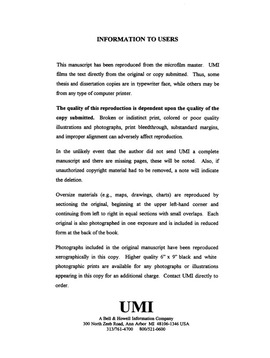| dc.contributor.advisor | Gilbert, M. Charles, | en_US |
| dc.contributor.author | Price, Jonathan Darrel. | en_US |
| dc.date.accessioned | 2013-08-16T12:30:22Z | |
| dc.date.available | 2013-08-16T12:30:22Z | |
| dc.date.issued | 1998 | en_US |
| dc.identifier.uri | https://hdl.handle.net/11244/5737 | |
| dc.description.abstract | The Mount Scott Granite intruded into the Carlton Rhyolite Group as part of a package of contiguous, consanguineous, and coeval (CCC) granites. Modeling of compositional data suggests the Mount Scott Granite shared a common parentage with two other granite plutons, the Medicine Park Granite and the Rush Lake granite, related by hornblende and plagioclase fractionation. These compositionally and spatially distinct plutons share contacts that imply near-simultaneous intrusion at the same crustal level. | en_US |
| dc.description.abstract | Investigation of the feldspar phases of the early Cambrian Mount Scott Granite, a unit of the Southern Oklahoma Aulacogen, reveals five distinct populations: (1) Na-rich (Or15--33) and (2) K-rich (Or 54--64) ovoid-shaped anorthoclase, many of which are mantled by (3) magmatic plagioclase (An12--31) rims, surrounded by a matrix containing (4) K-rich alkali feldspar (Or58--75) and rare, small grains of (5) primary plagioclase (An6--14). Thermodynamic modeling suggests the ovoid crystals and their mantles result from depressurization during magmatic ascent. The development of mantles appears dependent on the F concentration of the magma during crystallization. Experiments on titanite-fluorite equilibria conducted at 850° C, 200 MPa, ƒ O2 ≈ Ni - NiO buffer place initial F concentration ≈ 1 wt.% for the Mount Scott Granite magma. | en_US |
| dc.description.abstract | Following emplacement, the Mount Scott Granite was then intruded by at least one mafic pluton. Magnetic surveying, scientific drilling, and field geology defined the geometry of the Sandy Creek Gabbro as a steep walled pluton with a thin ledge protruding southward near its roof. The shape implies that the gabbro intrudes the granite. The Mount Scott Granite has since undergone significant fracture-controlled weathering at depths < 27 m that has altered the primary oxide mineralogy. | en_US |
| dc.description.abstract | Detailed mapping in the eastern Wichita Mountains defined the relationships of the Mount Scott Granite with adjacent lithologies, including its connection with the other CCC granites, and its intrusion into the Carlton Rhyolite Group. Additionally, mapping indicates that although fractures are prominent and locally intense, lithologic contacts within the Cambrian units show little evidence for juxtapositioning through faulting; most strongly suggest only an intrusive relationship. | en_US |
| dc.format.extent | xi, 240 leaves : | en_US |
| dc.subject | Mineralogy. | en_US |
| dc.subject | Geology. | en_US |
| dc.subject | Geochemistry. | en_US |
| dc.subject | Geology Oklahoma Wichita Mountains. | en_US |
| dc.subject | Petrology Oklahoma Wichita Mountains. | en_US |
| dc.title | Petrology of the Mount Scott Granite. | en_US |
| dc.type | Thesis | en_US |
| dc.thesis.degree | Ph.D. | en_US |
| dc.thesis.degreeDiscipline | Conoco Phillips School of Geology and Geophysics | en_US |
| dc.note | Source: Dissertation Abstracts International, Volume: 59-11, Section: B, page: 5753. | en_US |
| dc.note | Major Professor: M. Charles Gilbert. | en_US |
| ou.identifier | (UMI)AAI9911870 | en_US |
| ou.group | Mewbourne College of Earth and Energy::Conoco Phillips School of Geology and Geophysics | |
